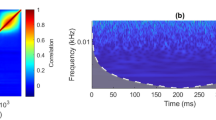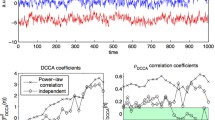Abstract.
Partial coherence measures the linear relationship between two signals after the influence of a third signal has been removed. Gersch proposed in 1970 that partial coherence could be used to identify sources of driving for multivariate time series. This idea, referred to in this paper as Gersch Causality, has received wide acceptance and has been applied extensively to a variety of fields in the signal processing community. Neurobiological data from a given sensor include both the signals of interest and other unrelated processes collectively referred to as measurement noise. We show that partial-coherence-based Gersch Causality is extremely sensitive to signal-to-noise ratio; that is, for a group of three or more simultaneously recorded time series, the time series with the highest signal-to-noise ratio (i.e., relatively noise free) is often identified as the “driver” of the group, irrespective of the true underlying patterns of connectivity. This hypothesis is tested both theoretically and on experimental time series acquired from limbic brain structures during the theta rhythm.
Similar content being viewed by others
References
Albo Z, Viana Di Prisco G, Truccolo W, Vertes RP, Ding M (2001) A study of neural interactions within the limbic system using partial coherence and direct transfer functions analysis. Soc Neurosci Abstr 27: 630
Albo Z, Viana Di Prisco G, Vertes RP (2003) Anterior thalamic unit discharge profiles and coherence with hippocampal theta rhythm. Thalamus Related Sys 2:133–144
Baccala LA, Sameshima K (2001) Partial directed coherence: a new concept in neural structure determination. Biol Cybern 84:463–474
Bendat JS, Piersol AG (1986) Random data: analysis and measurement procedures. Wiley, New York
Bernasconi C, Konig P (1999) On the directionality of cortical interactions studied by structural analysis of electrophysiological recordings. Biol Cybern 81:199–210
Cohen MI, Yu Q, Huang WX (1995) Preferential correlations of a medullary neuron’s activity to different sympathetic outflows as revealed by partial coherence analysis. J Neurophysiol 74:474–478
Efron B (1982) The jackknife, the bootstrap, and other resampling plans. SIAM, Philadelphia
Efron B, Tibshirani RJ (1993) An introduction to the bootstrap. Chapman & Hall, London
Fuller WA (1987) Measurement error models. Wiley, New York
Gersch W, Goddard GV (1970) Epileptic focus location: spectral analysis method. Science 169:701–702
Granger CWJ (1969) Investigating causal relations by econometric models and cross-spectral methods. Econometrica 37:424–438
Halliday DM, Rosenberg JR, Amjad AM, Breeze P, Conway BA, Farmer SF (1995) A framework for the analysis of mixed time series / point process data – theory and application to the study of physiological tremor, single motor unit discharges and electromyograms. Prog Biophys Mol Biol 64:237– 278
Kaminski M, Ding M, Truccolo WA, Bressler SL (2001) Evaluating causal relations in neural systems: granger causality, directed transfer function and statistical assessment of significance. Biol Cybern 85:145–157
Kocsis B, Vertes RP (1994) Characterization of neurons of the supramammillary nucleus and mammillary body that discharge rhythmically with the hippocampal theta rhythm in the rat. J Neurosci 14:7040–7052
Kocsis B, Bragin A, Buzsaki G (1999) Interdependence of multiple theta generators in the hippocampus: a partial coherence analysis. J Neurosci 19:6200–6212
Kubota D, Colgin LL, Casale M, Brucher FA, Lynch G (2003) Endogenous waves in hippocampal slices. J Neurophysiol 89:81–89
Larsen PD, Lewis CD, Gebber GL, Zhong S (2000) Partial spectral analysis of cardiac-related sympathetic nerve discharge. J Neurophysiol 84:1168–1179
Liang H, Ding M, Nakamura R, Bressler SL (2000) Causal influences in primate cerebral cortex during visual pattern discrimination. Neuroreport 11:2875–2880
Lopes da Silva FH, Vos JE, Mooibroek J, Van Rotterdam A (1980) Relative contributions of intracortical and thalamo-cortical processes in the generation of alpha rhythms, revealed by partial coherence analysis. Electroencephalogr Clin Neurophysiol 50:449–456
Mima T, Matsuoka T, Hallett M (2000) Functional coupling of human right and left cortical motor areas demonstrated with partial coherence analysis. Neurosci Lett 287:93–96
Rosenberg JR, Halliday DM, Breeze P, Conway BA (1998) Identification of patterns of neural connectivity – partial spectra, partial coherence, and neuronal interactions. J Neurosci Methods 83:57–72
Sherman DL, Tsai YC, Rossell LA, Mirski MA, Thakor NV (1997) Spectral analysis of a thalamus-to-cortex seizure pathway. IEEE Trans Biomed Eng 44:657–664
Sikes RW, Chronister RB, White LEJ (1977) Origin of the direct hippocampus – anterior thalamic bundle in the rat: a combined horseradish peroxidase – Golgi analysis. Exp Neurol 57:379–395
Swanson LW, Cowan WM (1977) An autoradiographic study of the organization of the efferent connections of the hippocampal formation in the rat. In: DeFrance J (ed) The septal nuclei, pp 37–64
Timmermann L, Gross J, Dirks M, Volkmann J, Freund HJ, Schnitzler A (2003) The cerebral oscillatory network of parkinsonian resting tremor. Brain 126:199–212
Turbes CC, Schneider GT, Morgan RJ (1983) Partial coherence estimates of brain rhythms. Biomed Sci Instrum 19:97–102
Turbes CC, Schneider GT (1989) Directionality of neural signals in central nervous system neural networks. Biomed Sci Instrum 25:1–5
Vertes RP, Albo Z, Viana Di Prisco G (2001) Theta rhythmically firing neurons in the anterior thalamus: implications for the mnemonic function of Papez’s circuit. Neuroscience 104(3):619–625
Wiener N (1956) The theory of prediction. Modern mathematics for engineers, Series 1, Beckenback EF, Ch 8
Author information
Authors and Affiliations
Corresponding author
Rights and permissions
About this article
Cite this article
Albo, Z., Di Prisco, G., Chen, Y. et al. Is partial coherence a viable technique for identifying generators of neural oscillations?. Biol. Cybern. 90, 318–326 (2004). https://doi.org/10.1007/s00422-004-0475-5
Received:
Accepted:
Published:
Issue Date:
DOI: https://doi.org/10.1007/s00422-004-0475-5




